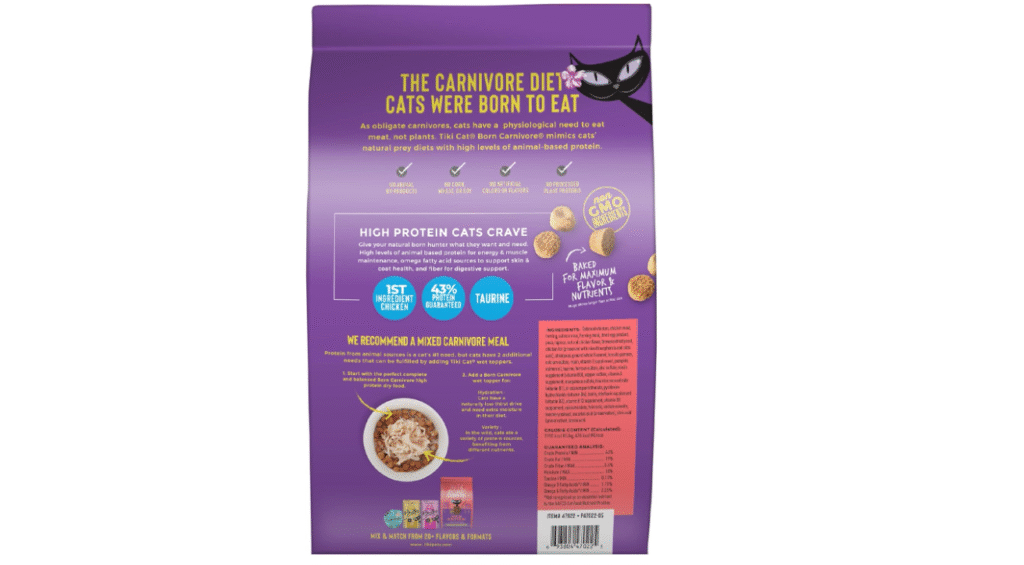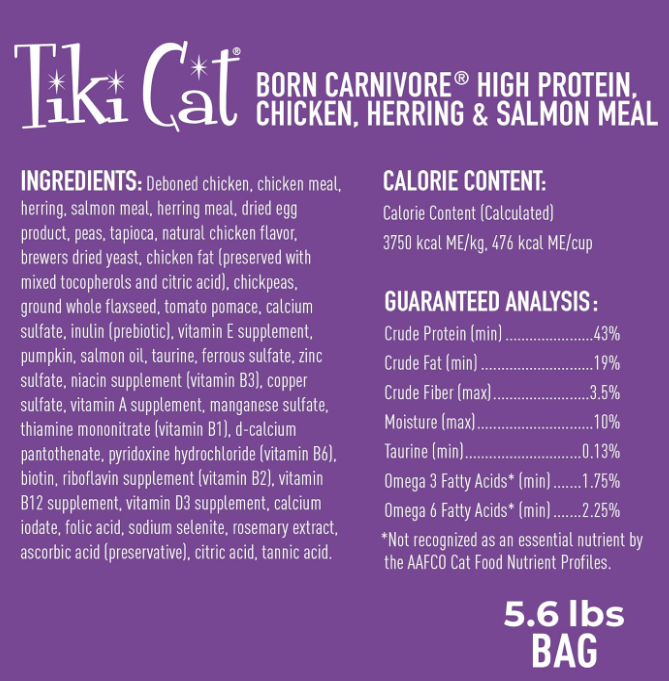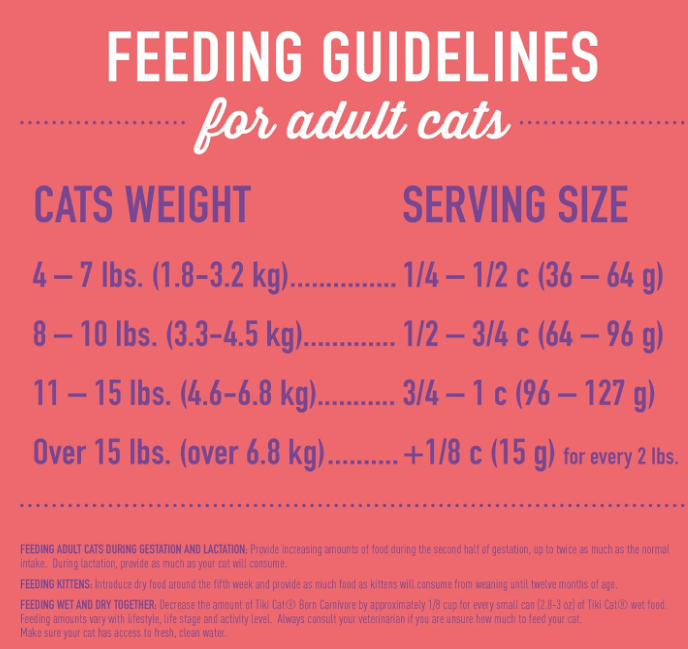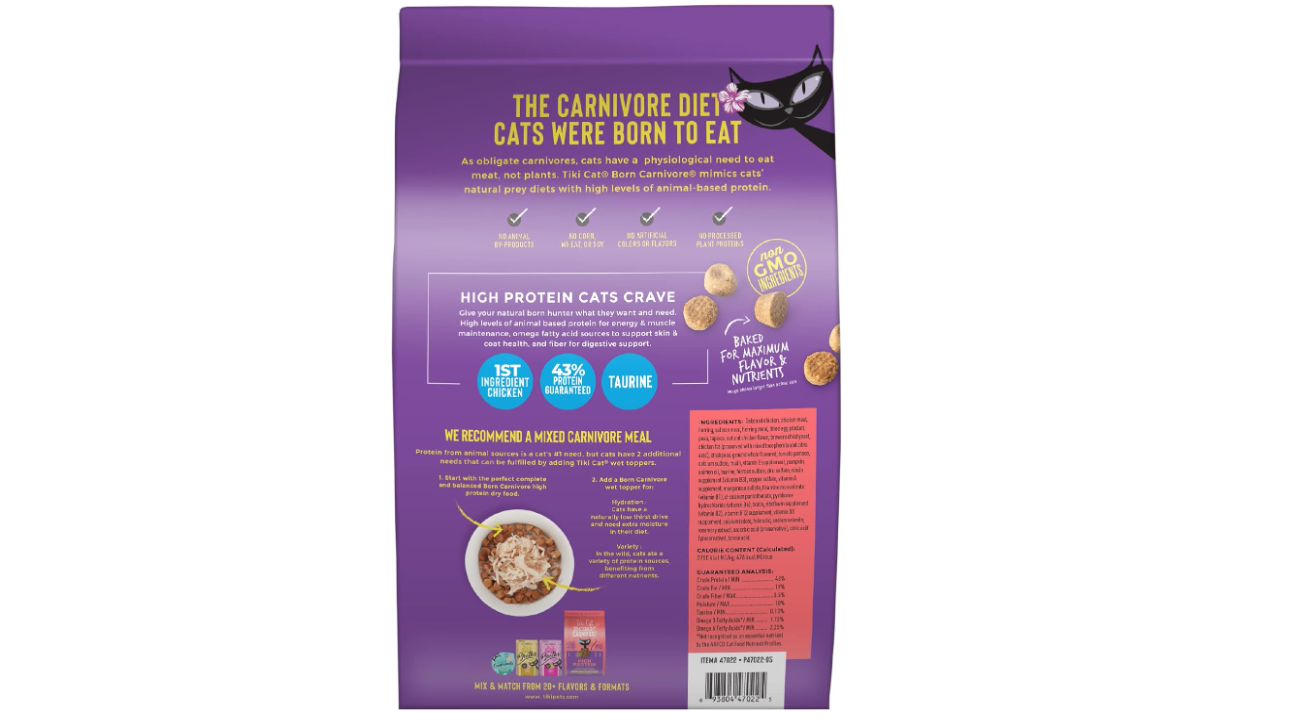When it comes to feeding your cat, there’s always that underlying tug-of-war between convenience and conscience. You want something easy to serve — but also something that feels right for your cat’s health, right down to the last bite. That’s probably what led you here, digging into a Tiki Cat cat food review, wondering whether this vividly packaged, high-protein line lives up to its growing reputation.
Spoiler: It’s not your average kibble or tuna mush in a can.
Tiki Cat has carved out a niche among cat owners who take nutrition seriously — the kind who read ingredient labels with the same scrutiny they’d give to their own food. With buzzwords like “high-moisture,” “grain-free,” and “human-grade ingredients” floating around, it’s easy to be intrigued… but also a little skeptical. Is it just slick branding, or is there genuine substance behind the tropical flair?
In this review, we’ll unpack everything — from ingredients and nutritional value to real user experiences and a candid look at potential drawbacks. Whether you’re feeding a fussy feline, a diabetic senior, or a kitten with a voracious appetite, this breakdown will help you decide if Tiki Cat is the right dish to put in their bowl.
Let’s dive in — because your cat can’t read labels, but you can.
Table of Contents
Quick Overview
Before diving deep into the ingredients, pros, and pet-parent feedback, here’s a snapshot of what Tiki Cat cat food brings to the table — literally.

| Product Name | Tiki Cat Cat Food (various lines) |
|---|---|
| Brand | Tiki Pets (a division of Whitebridge Pet Brands) |
| Type | Wet food, dry food, meal toppers, broths |
| Primary Use | Everyday feeding, picky eaters, special diets |
| Top Ingredients | Real meat or fish, broth, added vitamins/minerals |
| Free From | Grains, gluten, fillers, artificial additives |
| Available At | Petco, Chewy, Amazon, local pet stores |
| Ideal For | Cats with allergies, digestive issues, or low appetite |
| Popular Lines | Luau, Born Carnivore, Velvet Mousse, After Dark |
| Price Range | $$–$$$ (mid to premium-tier) |
| Where to Buy | Buy on Amazon or Chewy |
This quick snapshot helps frame the rest of the review. Tiki Cat isn’t trying to be the cheapest option on the shelf — it’s aiming for quality-conscious owners who are tired of mystery meat and dry food that might as well be cereal. Whether you’re supplementing a current diet or looking for a complete switch, knowing where it fits in the market is key.
What Is Tiki Cat Cat Food?
At first glance, Tiki Cat’s packaging is what catches your eye — colorful, tropical, unapologetically bold. But the brand’s real appeal lies beneath the lid. Tiki Cat cat food was created with a simple but revolutionary idea: cats should eat like carnivores, not corn lovers. That means real meat, real broth, and very few carbs — no gimmicks, no padding.
Founded by Christine Hackett, a passionate pet owner and pet industry professional, the Tiki brand emerged as part of a wave of premium pet foods challenging the old guard. Now under the umbrella of Whitebridge Pet Brands, Tiki Cat has become a go-to for owners of picky eaters, cats with food sensitivities, and anyone who just wants to serve up something better.
What Makes Tiki Cat Different?
Unlike many commercial cat foods that prioritize shelf life and cost-cutting over health, Tiki Cat leans hard into biologically appropriate nutrition:
- Protein First: Real cuts of chicken, tuna, lamb, beef, and organ meats.
- High Moisture: Many formulas mimic the hydration level of a prey diet — crucial for cats who rarely drink enough water.
- Minimal Carbs: No corn, wheat, soy, or unnecessary starches.
- Transparency: Ingredients you can recognize and pronounce, with detailed sourcing info on many SKUs.
There are multiple product lines under the Tiki Cat umbrella, each tailored to different preferences or needs:
- Luau Series: High-moisture foods in broth — think shredded meats.
- After Dark: Focused on organ meats and whole prey concepts.
- Born Carnivore: Dry food and treats formulated with 40%+ protein.
- Velvet Mousse: Smooth-textured wet food — a hit for cats with dental issues or soft food preferences.
Is Tiki Cat Considered a Complete Diet?
Yes — but with a caveat. Most Tiki Cat lines are labeled as “complete and balanced” according to AAFCO standards, meaning they meet the minimum nutritional requirements for cats. That said, some products (like their broths or toppers) are intended only for intermittent feeding. Always check the label, especially if your cat eats exclusively wet food.
Key Features & Benefits of Tiki Cat Cat Food
When you’re standing in the pet food aisle (or scrolling endlessly online), it’s easy to get overwhelmed by flashy packaging and vague claims. But Tiki Cat cat food stands out not just for what’s on the label — but for what’s in the can or bag. Here’s what sets it apart from the crowd, and why so many discerning cat parents swear by it.
High-Quality Animal Protein
At its core, Tiki Cat is all about meat. Whether it’s tuna, chicken, duck, or beef, the brand leads with real, identifiable cuts of protein — often as the first and second ingredients. This mimics a cat’s natural diet more closely than grain-laden or starch-heavy formulas.
- Why it matters: Cats are obligate carnivores. They don’t just like meat — they biologically need it for essential nutrients like taurine, which can’t be synthesized from plants.
Hydration Support from High-Moisture Content
A surprising number of cats live in a constant state of mild dehydration — mostly because dry kibble doesn’t provide the moisture they need, and many felines aren’t great about drinking water. Tiki Cat’s wet food lines (especially Luau and Velvet Mousse) are nearly 80% water.
- Why it matters: Proper hydration supports kidney health, urinary tract function, and overall digestion — especially crucial for older cats or those with medical conditions.
Free of Fillers and Artificial Junk
You won’t find grains, soy, corn, meat by-products, or artificial flavors in most Tiki Cat recipes. Instead, the focus is on short, clean ingredient lists — many of which look more like something out of a human meal prep plan than a pet food label.
- Why it matters: Fillers can lead to allergic reactions, weight gain, and digestion issues in sensitive cats.
Specialized Diets for Unique Needs – Tiki Cat Cat Food Review
- After Dark: Rich in organ meats, ideal for cats needing a nutrient-dense boost.
- Born Carnivore: A high-protein dry option with freeze-dried raw bits.
- Kitten-Specific Recipes: Formulated for growing bodies, with higher fat and DHA.
Whether your cat’s a picky princess or has a sensitive stomach, there’s likely a Tiki Cat line tailored to their quirks.

Potential Drawbacks of Tiki Cat Cat Food
No product is perfect — and despite its many high points, Tiki Cat cat food isn’t immune to critique. If you’re seriously considering a switch or long-term commitment, it’s worth pausing to explore the not-so-purrfect parts of the picture.
Price Point – Premium Food, Premium Cost
Let’s be real — feeding your cat Tiki Cat exclusively can get expensive. Depending on the formula and retailer, a single 2.8 oz can might cost between $1.20 and $2.00. For a household with multiple cats or large-breed felines, those costs add up fast.
- The tradeoff: You’re paying for quality ingredients and manufacturing — not mystery meat and cornmeal fillers. Still, price-sensitive buyers may need to mix it with other foods or reserve it for treat meals.
Limited Availability in Some Regions – Tiki Cat Cat Food Review
While widely available online (Amazon, Chewy, Petco), Tiki Cat isn’t always easy to find in brick-and-mortar stores — especially specialty flavors or product lines like Velvet Mousse or After Dark. This could be a problem for pet parents who prefer in-person shopping or need to restock quickly.
- Tip: Sign up for auto-ship on Chewy or Amazon to avoid running out, especially if your cat becomes obsessed (which… might happen).
Texture Can Be a Dealbreaker for Some Cats – Tiki Cat Cat Food Review
Tiki Cat prides itself on offering real shredded meat and natural textures — which is great in theory, but some cats just won’t touch it. If your cat is used to pâtés or dry food, transitioning can be rocky. The Velvet Mousse line is smoother, but still, texture rejection is a thing.
- Pro Tip: Try the variety packs first. Some cats need a slow introduction to new textures before committing.
Not All Products Are Complete Meals – Tiki Cat Cat Food Review
Certain Tiki Cat items — like broths, meal toppers, or treats — are meant to supplement a complete diet, not replace it. If fed exclusively, they could lead to nutritional imbalances.
- What to check: Look for the “complete and balanced” label (per AAFCO standards) before making any product your cat’s full-time food source.
How to Transition Your Cat to Tiki Cat Food
So you’re ready to ditch the dull kibble or mystery-meat pâté — but let’s pump the brakes for a second. Cats are notoriously suspicious of change, especially when it messes with their routine (or their food bowl). Transitioning to Tiki Cat cat food the wrong way can backfire fast: digestive upset, food refusal, or a full-blown hunger strike. But done right? Your cat could be purring through every meal.
A Gentle Step-by-Step Transition Plan
Here’s how to introduce Tiki Cat without drama — or vomit.
- Days 1–2: Mix 75% of your cat’s current food with 25% Tiki Cat.
- Days 3–4: Go 50/50 — half old, half new.
- Days 5–6: Shift to 75% Tiki Cat and 25% old food.
- Day 7+: Fully switch to Tiki Cat if your cat is handling it well.
- Tip: Some cats may need even slower transitions. Stretch the timeline as needed.
- Watch for: Soft stools, vomiting, refusal to eat. If these persist past a few days, pause and consult your vet.
Texture & Temperature Tricks
Tiki Cat’s high-moisture formulas and shredded textures are a big shift from dry food or compact pâtés. If your cat is skeptical:
- Warm it up slightly: A few seconds in the microwave (never in the can) can enhance aroma.
- Add a topper: A sprinkle of freeze-dried treats or broth can tempt reluctant eaters.
- Use food puzzles or licki mats: These can make the new food feel like play instead of punishment.
Transitioning Kittens vs. Adult Cats / Tiki Cat Cat Food Review
- Kittens: Often more flexible — just ensure you’re using a kitten-specific formula with DHA and extra calories.
- Seniors: May require extra patience, especially if they have dental issues or chronic conditions.
Customer Reviews & Testimonials
No brand story is complete without the voices of the people (and paws) who’ve actually lived with the product. In the case of Tiki Cat cat food, the feedback ranges from ecstatic praise to a few “meh” reactions — which, honestly, is about as real as it gets in the cat world.
The Rave Reviews / Tiki Cat Cat Food Review
Many cat parents are all-in on Tiki Cat, praising it for transforming their feline’s health, appetite, or overall demeanor. Some common high notes:
- “My picky eater finally eats something consistently.”
- Cats known for sniffing and rejecting everything are suddenly finishing meals — especially the Velvet Mousse and After Dark lines.
- “Improved digestion and coat condition.”
- Several owners of cats with IBD or food sensitivities report firmer stools, less vomiting, and shinier fur within weeks.
- “Smells like real food.”
- Unlike some wet foods that have that…questionable scent, Tiki Cat’s formulas often smell like actual meat or fish — which reassures humans and tempts cats alike.
- “Worth the price.”
- While it’s not cheap, many reviewers justify the cost with the health improvements and reduced vet visits.
The Mixed or Negative Feedback / Tiki Cat Cat Food Review
That said, not every bowl is licked clean. Some recurring criticisms include:
- “Too expensive to feed long-term.”
- Especially for multi-cat homes or larger breeds, feeding Tiki Cat exclusively can break the budget.
- “My cat wouldn’t touch it.”
- Texture and scent rejections are the most common complaints, particularly for cats used to dry food or classic pâtés.
- “Dented cans, inconsistent quality.”
- A few buyers mention damaged shipments or slight inconsistencies in can texture — though these are often tied to third-party sellers rather than Tiki Cat itself.
Comparison with Alternatives / Tiki Cat Cat Food Review
It’s one thing to say a food is “good” — it’s another to understand how it stacks up against others in the same premium space. If you’re comparing Tiki Cat cat food to brands like Weruva, Fancy Feast Gourmet Naturals, or Orijen, you’re not alone. Below, we break down how Tiki Cat holds its own — and where it might come up short.
Tiki Cat vs. Weruva
- Protein & Moisture: Both brands emphasize high-protein, high-moisture content, with visible cuts of real meat.
- Texture Options: Weruva offers more variety in textures (gravies, aspic, shreds), while Tiki Cat leans heavily on shredded or mousse-like options.
- Cost: Fairly comparable per ounce, though Weruva’s “Truluxe” line is slightly pricier.
- Winner?: Tie — Weruva might win for cats who like more gravy or variety, but Tiki Cat often gets the edge for cleaner labels.
Tiki Cat vs. Fancy Feast Gourmet Naturals / Tiki Cat Cat Food Review
- Ingredient Quality: Tiki Cat uses simpler, cleaner ingredient lists without artificial flavors or meat by-products. Fancy Feast still uses more synthetic vitamins and less transparent meat sourcing.
- Price: Fancy Feast is significantly more affordable.
- Availability: Fancy Feast wins in terms of being stocked everywhere.
- Winner?: Tiki Cat — for ingredient-conscious owners. But Fancy Feast may be a better “budget upgrade” for owners making a slow transition from standard food.
Tiki Cat vs. Orijen (Dry Food) Tiki Cat Cat Food Review
- Protein Levels: Orijen’s dry food (like their Six Fish or Cat & Kitten recipes) is incredibly high in protein — often 40%+, rivaling Tiki Cat’s Born Carnivore line.
- Moisture: Orijen is dry; Tiki Cat’s strength is in its moisture-rich formulas.
- Cost: Both are premium-priced, though Orijen’s dry format may stretch farther per serving.
- Winner?: Depends on your feeding style — Orijen for high-protein kibble lovers, Tiki Cat for those who prioritize hydration.

Frequently Asked Questions (FAQs)
Every cat parent has a few lingering “what ifs” before switching up their feline’s food. Below are some of the most common questions asked about Tiki Cat cat food, answered with clarity and nuance.
Is Tiki Cat food suitable for kittens?
Answer: Yes — Tiki Cat offers specific kitten formulas, such as those in the Luau and Born Carnivore lines, which are higher in fat and calories to support growth. Always look for the label indicating the product is “complete and balanced for growth.”
Can I feed Tiki Cat exclusively?
Answer: Absolutely — as long as you’re choosing one of their complete and balanced formulas (check the label for AAFCO compliance). However, some lines like the broths or toppers are meant only as supplements. A rotation of wet and dry or across different lines can offer variety while meeting full nutritional needs.
Tiki Cat Cat Food Review – Does Tiki Cat make dry food?
Answer: Yes — the Born Carnivore line includes high-protein, grain-free dry foods and air-dried options with freeze-dried raw bits. It’s formulated to mimic a prey-based diet, though hydration should still be monitored if feeding primarily dry.
Tiki Cat Cat Food Review – Is Tiki Cat food made in the USA?
Answer: It depends on the product. Some Tiki Cat foods are made in Thailand (where human food manufacturing standards are very high), while others — especially the dry foods — are produced in the USA. Always check packaging for specifics.
Tiki Cat Cat Food Review -How long can Tiki Cat food sit out?
Answer: Opened wet food should not sit out for more than 30–60 minutes at room temperature, especially in warmer climates. Refrigerate unused portions and use within 2–3 days for optimal freshness.
Tiki Cat Cat Food Review
rigby cat
cat couple doodle
pete the cat costume
smirking cat

